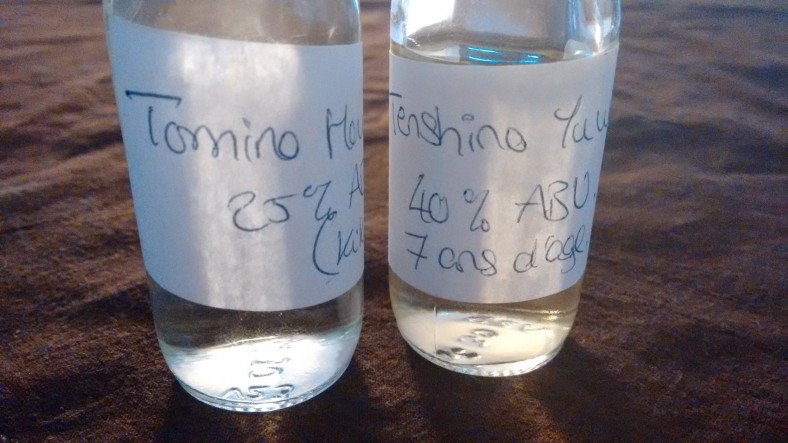When they say you can make alcohol from anything… they weren’t joking. This week, I have two samples of shochu to share with you.
In case you’re not familiar with shochu, very simply, it’s a distilled alcohol made in Japan.
There has been a huge buzz around Japanese whiskies recently. I’ve been lucky enough to witness the growth of one of these brands first-hand but that’s a story for another day.
Shochu will never have that same widespread appeal. It is a far more culturally entrenched product. Whereas whisky has only been made in Japan since the days of Shinjiro Torii and Masataka Taketsuru (grosso modo, the 1920s), shochu can trace its production back over 500 years to the 15th century.
How is shochu made?
The principal components are water, koji, yeast and a base ingredient. You can use practically anything as the base ingredient – 40 different possibilities are permitted – but the most common are rice, barley and sweet potato.
kome = rice
mugi = barley
imo = sweet potato
kokuto = brown sugar
soba = buckwheat
sakekasu = sake lees
But first of all, you have to choose your koji. Koji are mold spores which serve as a fermenting agent for your base ingredient. It provides an enzyme that breaks down the starch molecules into sugars which can then be fermented. (I know that doesn’t sound at all pleasant but, when you think about it, it’s not far off the process of malting barley in whisky production.) The preparation of koji mixed with water and cultivated yeast is called the moromi.
kuro = black
The most traditional type of koji – it is now most often used in the production of awamori.
shiro = white
This mutation on the black koji first appeared in the 1910-1920s. It is said to be a very powerful koji and easier to handle than the black. It is most often used for making korui shochu.
ki = yellow
The yellow koji, first used in sake brewing, has become rather popular nowadays despite being extremely sensitive to temperature fluctations during the brewing stage.
Once the koji is ready, it is added to the base ingredient for a second fermentation before the distillation. For honkaku shochu (the “authentic” variety) only one distillation (in a pot still) is allowed and there can only be one kind of base ingredient. This is the opposite of korui shochu which is typically a blend of multiple base ingredients and can be produced by a column distillation.
How do you drink shochu?
There are several ways: straight (which rather like missionary-style is practical but not always the most enjoyable.) Second: on the rocks. Alternatively, it is traditional in Japan to drink shochu diluted with hot water. Apparently, they pour hot (not boiling) water into a ceramic cup and top it up with honkaku shochu. A fourth, and more contemporary, method would be in cocktails. I can totally imagine a sizzling hot variation on a Bloody Mary being made with shochu. There are savoury, slightly umami characters that, in the hands of a good mixologist, could be amazing. To write the following tasting notes, I did methods 1 and 3.
TOMINO HOUZON honkaku shochu (25%)
This is made from sweet potato (imo) at the Nishi Shuzo Distillery in the Kagoshima Prefecture on Kyushu Island (aka shochu heartland, right in the south of Japan) and made using the slow-acting yellow koji (kikoji.)
At first, I am astonished by the fruity and floral aroma. It is light, clean and with no strong alcohol presence. There is a slight sweetness too. Upon taking a sip, some earthy spice becomes apparent. It is very smooth (clearly just the heart of the distillation) and I am told that one of the characteristics that you typically find in shochu made with kikoji is a mellowness. I can’t argue. This is indeed very pleasant.
I’m rather disappointed by the fact that I only have a small 4cl sample of this. I would happily share this amongst friends as an introduction to shochu. You may think you won’t like a white spirit made with mouldy sweet potato… well, I dare you to try this!
Price: €€
Rating: ****
TENSHINO YUWAKU honkaku shochu (40%)
This is also an imo shochu from the Nishi Shuzo Distillery. I learn that the distillery was founded in 1845. This shochu, whose name translates as “the angel’s temptation”, was aged in refill-sherry, oak barrels for 7-8 years.
Oh gosh, this is far more original. There’s a musty smell jumping out of the glass. It reminds me of the smell of a freshly-opened tub of play-doh. That’s probably a reference that will speak to a very limited audience. How else can I describe it? A bit chocolatey, a bit smoky, a bit musky.
The mouthfeel is also more powerful and more complex. You do feel the 40% alcohol. Diluted with water, it becomes much smoother and refreshing. There is still a taste of chocolate but it releases more subtle aromas too. Clearly a very high-quality alcohol but for the price (I’m told this retails at around 80 euros for 70cl) it will remain a very niche product.
Price: €€€
Rating: ****


